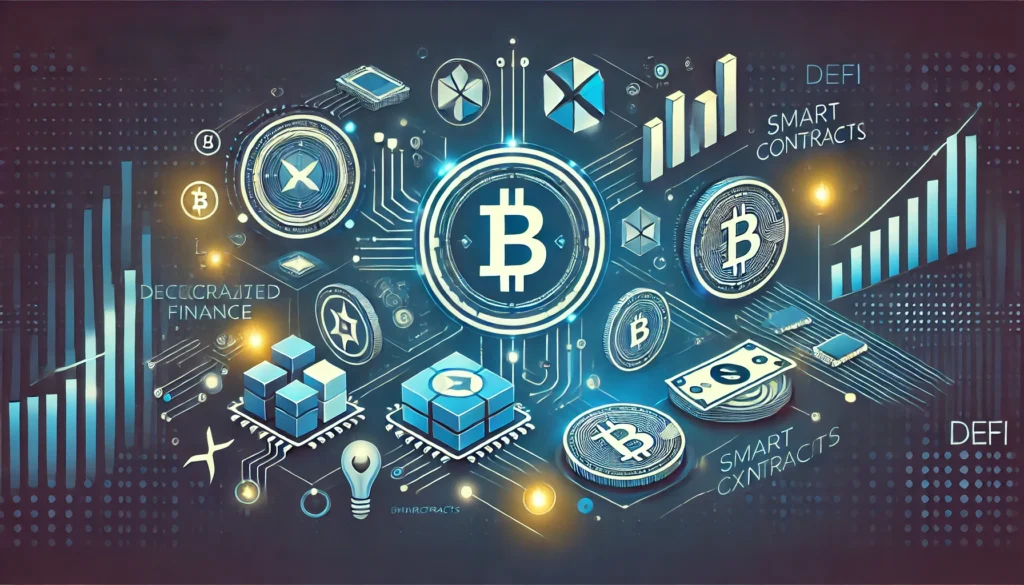
Decentralized Finance, commonly known as DeFi, is transforming the global financial landscape by providing a decentralized, transparent, and open alternative to traditional banking and financial systems. With the ability to bypass intermediaries like banks and brokers, DeFi leverages blockchain technology to enable secure and accessible financial services for everyone.
What is DeFi?
DeFi refers to a suite of financial applications built on blockchain networks, primarily Ethereum. Unlike traditional finance, where centralized institutions manage transactions, DeFi operates on decentralized protocols that allow peer-to-peer interactions.
Key Characteristics of DeFi
- Decentralization: No single entity controls the system.
- Transparency: Transactions and protocols are publicly auditable.
- Accessibility: Services are available to anyone with an internet connection.
- Programmability: Smart contracts automate processes and enforce agreements.
Core Components of DeFi
DeFi is composed of various protocols and applications that replicate traditional financial services in a decentralized manner.
1. Decentralized Exchanges (DEXs)
- Examples: Uniswap, SushiSwap
- Function: Allow users to trade cryptocurrencies directly without intermediaries.
- Benefits: Reduced fees, increased privacy, and no need for account creation.
2. Lending and Borrowing Platforms
- Examples: Aave, Compound
- Function: Enable users to lend their crypto assets to earn interest or borrow assets by providing collateral.
- Benefits: No credit checks, global accessibility, and automated processes.
3. Stablecoins
- Examples: USDT, DAI, USDC
- Function: Cryptocurrencies pegged to stable assets like the US Dollar.
- Benefits: Minimize volatility while maintaining blockchain’s advantages.
4. Yield Farming and Staking
- Examples: Yearn Finance, PancakeSwap
- Function: Allow users to earn rewards by providing liquidity or staking tokens.
- Benefits: High potential returns with passive income opportunities.
5. Insurance Protocols
- Examples: Nexus Mutual, InsurAce
- Function: Offer coverage against smart contract failures and hacks.
- Benefits: Enhanced security and trust for users.
How DeFi Works
DeFi relies on blockchain networks and smart contracts to function. Here’s a simplified breakdown:
- Smart Contracts:
- Self-executing programs that define the terms of an agreement.
- Ensure transparency and eliminate the need for intermediaries.
- Liquidity Pools:
- A collection of user-deposited funds used for trading, lending, and staking.
- Users receive rewards for contributing to these pools.
- Interoperability:
- Most DeFi platforms operate on Ethereum, but new chains like Binance Smart Chain and Solana are gaining traction.
Advantages of DeFi
- Financial Inclusion:
- Accessible to anyone, regardless of location or socioeconomic status.
- Lower Costs:
- Eliminates intermediaries, reducing transaction fees.
- Transparency:
- Users can audit protocols and track transactions in real-time.
- Control Over Assets:
- Users maintain full ownership of their funds.
Challenges and Risks of DeFi
While DeFi offers numerous benefits, it’s not without risks:
1. Smart Contract Vulnerabilities
- Bugs or errors in smart contracts can lead to hacks or losses.
2. Market Volatility
- High price fluctuations can affect collateralized loans and yield farming rewards.
3. Regulatory Uncertainty
- Lack of global standards makes compliance challenging.
4. Complexity
- New users may find DeFi platforms overwhelming due to their technical nature.
DeFi vs Traditional Finance
| Feature | DeFi | Traditional Finance |
|---|---|---|
| Intermediaries | None (peer-to-peer) | Banks, brokers, and other institutions |
| Transparency | Fully transparent | Limited; controlled by institutions |
| Access | Open to anyone | Restricted; may require documentation |
| Fees | Lower; no intermediaries | Higher; includes intermediary fees |
| Speed | Near-instant transactions | Slower; depends on banking hours |
Future of DeFi
1. Cross-Chain Interoperability
DeFi platforms are working toward seamless integration across multiple blockchains, enabling better asset transfer and collaboration.
2. Enhanced Security Measures
With advancements in auditing tools and insurance protocols, DeFi is becoming safer for users.
3. Mainstream Adoption
As awareness grows, institutions and governments are exploring DeFi applications, such as Central Bank Digital Currencies (CBDCs).
4. User-Friendly Interfaces
Simplified interfaces and educational resources are making DeFi more accessible to non-technical users.
How to Get Started with DeFi
- Choose a Wallet:
- Use wallets like MetaMask or Trust Wallet to interact with DeFi protocols.
- Fund Your Wallet:
- Purchase cryptocurrency and transfer it to your wallet.
- Select a Platform:
- Research platforms based on your financial goals, such as lending, trading, or staking.
- Start Small:
- Begin with small investments to understand the risks and mechanics.
- Stay Informed:
- Follow trusted DeFi news sources and communities.
Conclusion
DeFi is reshaping the financial ecosystem by offering decentralized, transparent, and accessible alternatives to traditional systems. While the industry faces challenges, its potential to democratize finance and empower individuals worldwide is undeniable. By understanding its core concepts, advantages, and risks, you can leverage DeFi to participate in the future of finance.